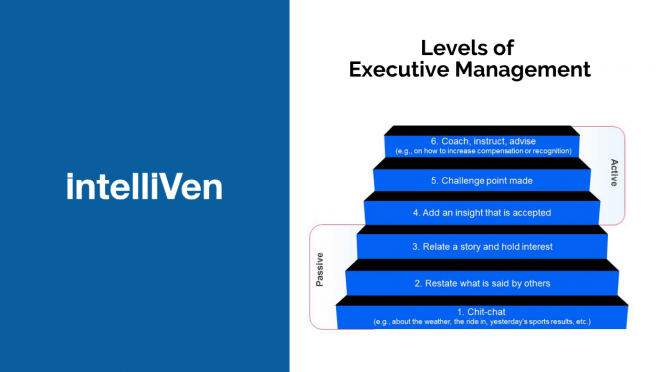An up-and-coming executive engages with an important sales prospect, client, supplier, partner, or colleague on par with their degree of comfort and security with the other party. The more seniority the other is perceived to have relative to their own, the more anxiety and insecurity is induced, the less is said, and the less impact results from the interaction.
Pushing to engage at the highest possible level drives the best results and accelerates career progression. It helps to think of it as climbing a six-level staircase. 
Take One Step at a Time
The first step is the most basic level of engagement, is easy enough to do, but adds little-to-no value. Each step is easier than otherwise when it builds off of the last, but is progressively more difficult and riskier to take.
The top step generates extraordinary value and takes the most effort and nerve to do, especially for the first time.
Take the Steps in Order
Take the steps in order, go as high as possible in an interaction, and then strive to achieve a higher level next time. With each experience and successful interaction, the executive matures, gains perspective, and gets on track to providing maximum value and career growth.
The steps are easier to climb if the emerging executive is more senior in terms of age or position than the other party. Less-experienced executives need to muster the courage and determination, early in their career, to move up the steps of engagement when given the opportunity.
Their instinct may be to demur and leave things to more senior players in their chain of command. Managers tend to jump in, thinking it is safer to take over rather than encouraging up-and-comers to interact with prospects, customers, suppliers, partners, and colleagues who are more senior. They are wrong … and should do just the opposite to create the opporutinity for learning and growth.
You Don’t Have to Wait or Take the Steps Alone
Not pushing to the next step may seem like the safer course but the limit of that strategy means hitting the top step only after many years of experience. There is no reason even for the earliest-stage executive to wait until their gray hair comes naturally to realize their full potential to generate great value. Anyone can climb the stairs at any point in their career. Sooner is better.
In the quest to provide top value, up-and-coming executives may wonder how they could possibly add insights, challenge points, and provide useful coaching, instruction, and advice (that is, climbing steps four, five, and six) with only a few years of knowledge and experience.
The good news is that no one, even the most junior professional, has to do it alone. The full breadth and weight of the organization’s experience and wisdom can and should be drawn on and put to work preparing for every high-stakes executive interaction.
Strive to Do the Most Good
Those who most effectively draw upon, internalize, use, and add to the broader capacity and competence of their organization’s collective knowledge and experience with each executive engagement will do the most good and earn the right to do even more the soonest.
Strive to operate in every situation as the best and most informed in the organization would if they could. Doing so is a highly coveted form of leverage that allows a person to perform at a far higher level than one would expect and serves their, and their organization, well.
More for Up-and-Coming Executives:
IntelliVen Manage to Lead Immersion Program
Seven Truths to Help You Change the World
- Describe, launch, drive, and govern Strategic Initiatives.
- Foster and achieve the change you want.
- Become a better and more confident strategic thinker and leader.
Editors Note: This post was originally published on October 8, 2012, and updated in 2020 and again in 2023.

